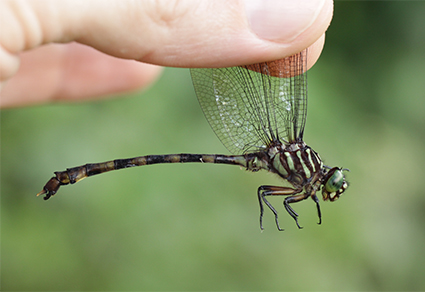Abstract
A new species of the Neotropical dragonfly genus Gomphoides Selys, 1854 (Odonata: Gomphidae) is erected from the Cerrado of central Brazil, distinguished by epiproct morphology, body coloration and wing venation. Gomphoides davi Datto-Liberato & Guillermo-Ferreira sp. nov. resembles G. perdita (Förster, 1914), but is distinguished from it by the S10 black, while it is yellow in G. perdita; four cells in the subtriangle of Fw while there are three cells in G. perdita and epiproct shorter than half of the length of cerci while epiproct is more than half the length of the cerci in G. perdita. We also provide additional information for other Gomphoides species. The discovery of a new species in the Environmental Protection Area of the Uberaba River, Minas Gerais, raises concern for the conservation of the biodiversity of the area, mainly because of recent threats due to cattle herding and agriculture.
References
Almeida, M.V.O., Pinto, Â.P., Carvalho, A. do L. & Takiya, D.M. (2013) When rare is just a matter of sampling: Unexpected dominance of clubtail dragonflies (Odonata, Gomphidae) through different collecting methods at parque nacional da serra do cipó, minas gerais state, Brazil. Revista Brasileira de Entomologia, 57, 417–423. https://doi.org/10.1590/S0085-56262013005000042
Belle, J. (1984) Idiogomphoides, a new genus from Brazil (Odonata: Gomphidae). Entomologische Berichten, 44, 106–109.
Belle, J.B. (1995) On the female sex of some elusive South-American Gomphidae with the descriptions of three new genera and four new species (Odonata). Zoologische Mededelingen, 69, 20–36.
Dalzochio, M., Costa, J. & Uchôa, M. (2011) Diversity of Odonata (Insecta) in lotic systems from Serra da Bodoquena Mato Grosso do Sul State, Brazil. Revista Brasileira de Entomologia, 55, 89–94.
Garrison, R.W., von Ellenrieder, N. & Louton, J.A. (2006) Dragonfly Genera of the New World: An Illustrated and Annotated Key to the Anisoptera. The Johns Hopkins University Press, Baltimore, Maryland, 368 pp.
Gloyd, L. (1973) The status of the generic names Gomphoides, Negomphoides, Progomphus, and Ammogomphus (Odonata: Gomphidae). Occasional papers of the Museum of Zoology University of Michigan, 668, 1–7.
Gloyd, L. (1974) A correction concerning the gender of the generic name Gomphoides (Anisoptera: Gomphidae). Odonatologica, 3, 179–180.
Guillermo-Ferreira, R., Vilela, D.S., Del-Claro, K. & Bispo, P.C. (2016) Erythrodiplax ana sp. nov. (Odonata: Libellulidae) from Brazilian palm swamps. Zootaxa, 4158 (2), 292–300. https://doi.org/10.11646/zootaxa.4158.2.10
Koroiva, R., Neiss, U.G., Fleck, G. & Hamada, N. (2020) Checklist of dragonflies and damselflies (Insecta: Odonata) of the Amazonas State, Brazil. Biota Neotropica, 20 (1), e20190877. https://doi.org/10.1590/1676-0611-BN-2019-0877
Lozano, F., del Palacio, A., Ramos, L. & Muzón, J. (2020) The Odonata of Argentina: state of knowledge and updated checklist. International Journal of Odonatology, 23, 113–153. https://doi.org/10.1080/13887890.2020.1737585
QGIS (2022) QGIS Geographic Information System. QGIS Association. Available from: http://www.qgis.org (accessed 28 June 2022)
Ribeiro, C., Firme, B., Araujo, S.A., de Sá, A., Zander, F., Teixeira, K., Santos, L.R. & Rodrigues, M.E. (2021) Check-list of Odonata from the state of Bahia, Brazil: ecological information, distribution, and new state records. Odonatologica, 50 (3–4), 161–186.
Riek, E.F. & Kukalová-Peck, J. (1984) A new interpretation of dragonfly wing venation based upon Early Upper Carboniferous fossils from Argentina (Insecta: Odonatoidea) and basic character states in pterygote wings. Canadian Journal of Zoology, 62, 1150–1166. https://doi.org/10.1139/z84-166
St Quentin, D. (1973) Die Gomphidenfauna Südamerikas (Ordn.: Odonata). Annalen des Naturhistorischen Museums in Wien, 77, 335–363.
Valera, C.A., Pissarra, T.C.T., Filho, M.V.M., do Valle Júnior, R.F., Oliveira, C.F., Moura, J.P., Fernandes, L.F.S. & Pacheco, F.A.L. (2019) The buffer capacity of riparian vegetation to control water quality in anthropogenic catchments from a legally protected area: A critical view over the Brazilian new forest code. Water, Switzerland, 11, 549. https://doi.org/10.3390/w11030549
Valera, C.A., Valle Junior, R.F., Varandas, S.G.P., Sanches Fernandes, L.F. & Pacheco, F.A.L. (2016) The role of environmental land use conflicts in soil fertility: A study on the Uberaba River basin, Brazil. Science of the Total Environment, 562, 463–473. https://doi.org/10.1016/j.scitotenv.2016.04.046
Venâncio, H., Vilela, D.S., Barbosa, M.S. & Santos, J.C. (2021) Dragonflies and damselflies in a region of the triângulo mineiro, Minas Gerais checklist and taxonomic additions. Biota Neotropica, 21 (3), e20201182. https://doi.org/10.1590/1676-0611-bn-2020-1182
Vieira, A.S., do Valle Junior, R.F., Rodrigues, V.S., da Silva Quinaia, T.L., Mendes, R.G., Valera, C.A., Fernandes, L.F.S. & Pacheco, F.A.L. (2021) Estimating water erosion from the brightness index of orbital images: A framework for the prognosis of degraded pastures. Science of the Total Environment, 776, 146019. https://doi.org/10.1016/j.scitotenv.2021.146019
Vilela, D.S., Ferreira, R.G. & Del-Claro, K. (2016) Odonata community of a Brazilian vereda: seasonal patterns, species diversity and rarity in a palm swamp environment. Bioscience Journal, 32, 486–495. https://doi.org/10.14393/BJ-v32n2a2016-30491


